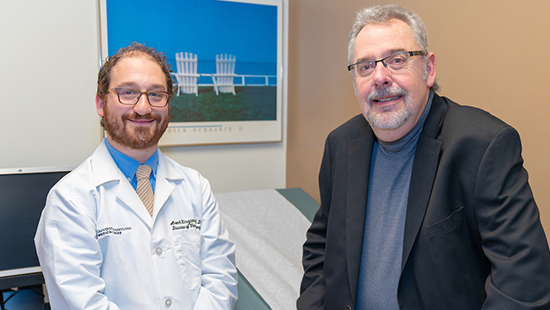Patient Survives ‘Double Whammy’ Abdominal Aortic Aneurysm and Heart Attack

Anthony Christiani knows he’s lucky to be alive.
While standing in his kitchen during the summer of 2018, he felt a sudden, sharp pain in his lower abdomen.
“It was like someone shoved a knife in and disemboweled me,” the 58-year-old retired Frederick, Maryland resident said. “It knocked me to my knees.”
Moments after arriving at a local hospital, he began excessively sweating and became lightheaded. Tests revealed Christiani had experienced a double whammy: a ruptured, softball-sized abdominal aortic aneurysm (AAA), followed by a heart attack. Both are life-threatening conditions.
“As soon as I knew I was being transported to University of Maryland Medical Center, I knew I had a chance to survive,” Christiani said.
Nine years ago, doctors at the University of Maryland Medical Center saved his father’s life during a pancreatitis attack. The hospital had the experience and the expertise to now save his, Christiani said.
Areck Ucuzian, MD, PhD, Assistant Professor of Surgery at the University of Maryland School of Medicine, specializes in vascular disease and knew as soon as Christiani arrived via helicopter that surgery was necessary.
First, Dr. Ucuzian repaired the aneurysm. Next, Mark Vesely, MD, Associate Professor of Medicine at the University of Maryland School of Medicine, placed three stents in Christiani’s heart to open the clogged blood vessels that caused his heart attack.
Because Christiani had just experienced a heart attack, he could only receive local anesthesia.
“I could hear the doctors and the urgency in their voices,” he recalled. “I knew it was serious. On the table, I said to myself, ‘I’m not leaving this world today.’”
Abdominal aortic aneurysms occur when the aorta, the largest blood vessel in the body, weakens and bulges. Ruptures can cause life-threatening bleeding. These types of aneurysms can also force blood away from organs and tissues, leading to heart attacks, stroke or even death. In these emergent situations, immediate treatment from a vascular specialist is essential.
“The vascular specialists at the University of Maryland Medical Center have extensive experience repairing abdominal aortic aneurysms,” Dr. Ucuzian said. “In complex cases like Mr. Christiani’s, we employ a full, multidisciplinary approach to care. That means we have teams of cardiologists, cardiac surgeons, vascular surgeons, intensivists and rehabilitation specialists all working together to ensure our patients receive high quality, comprehensive care from the moment they arrive.”
After the procedures, Christiani spent several days in the trauma center recovering. While there, he asked the doctors and nurses, “What are my chances of surviving this?’”
“I told them not to sugar coat it,” he said. “They said, ‘The survival rate was in the single digits.’”
Christiani attributes his successful recovery to a higher power and the dedicated nurses and doctors at the University of Maryland Medical Center.
“I know something extraordinary happened,” he said. “And the quality of the nurses and doctors didn’t surprise me at all. The surprise is that I’m alive.”
He added: “I am truly humbled and forever grateful to the miracle workers who saved my life that day. I’m just trying to be patient, to be a good patient and to live in the moment.”
